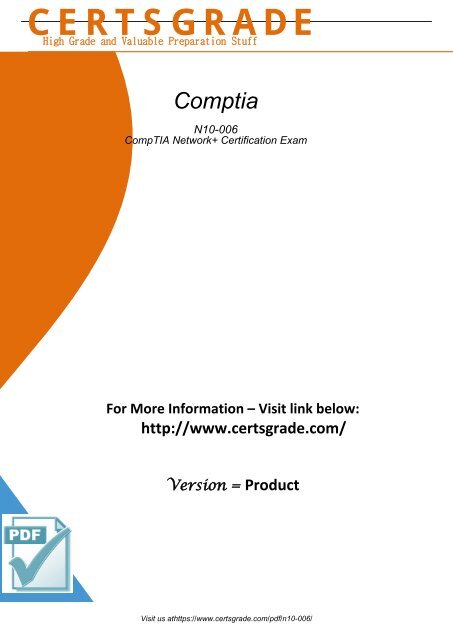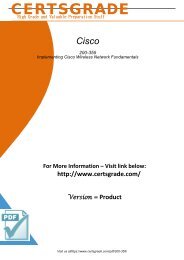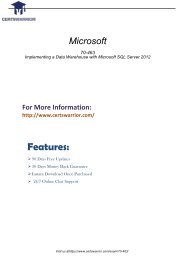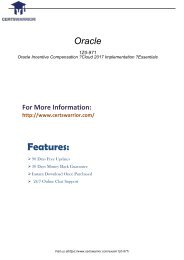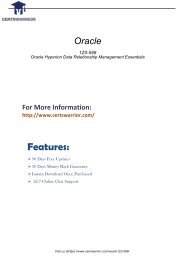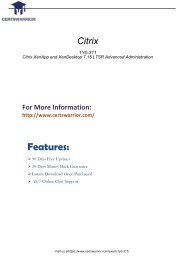N10-006 Study Material
We offer you free sample questions along answers prepared by the professionals of the IT field. You can easily pass your N10-006 Test with our Training Kits. For more info please visit here: http://www.certsgrade.com/pdf/N10-006/
We offer you free sample questions along answers prepared by the professionals of the IT field. You can easily pass your N10-006 Test with our Training Kits. For more info please visit here: http://www.certsgrade.com/pdf/N10-006/
You also want an ePaper? Increase the reach of your titles
YUMPU automatically turns print PDFs into web optimized ePapers that Google loves.
CERTSGRADE<br />
High Grade and Valuable Preparation Stuff<br />
Comptia<br />
<strong>N10</strong>-<strong>006</strong><br />
CompTIA Network+ Certification Exam<br />
For More Information – Visit link below:<br />
http://www.certsgrade.com/<br />
Version = Product<br />
Visit us athttps://www.certsgrade.com/pdf/n10-<strong>006</strong>/
Question: 1<br />
A technician needs to limit the amount of broadcast traffic on a network and allow different segments<br />
to communicate with each other. Which of the following options would satisfy these requirements?<br />
A. Add a router and enable OSPF.<br />
B. Add a layer 3 switch and create a VLAN.<br />
C. Add a bridge between two switches.<br />
D. Add a firewall and implement proper ACL.<br />
Answer: B<br />
Explanation:<br />
We can limit the amount of broadcast traffic on a switched network by dividing the computers into<br />
logical network segments called VLANs.<br />
A virtual local area network (VLAN) is a logical group of computers that appear to be on the same LAN<br />
even if they are on separate IP subnets. These logical subnets are configured in the network switches.<br />
Each VLAN is a broadcast domain meaning that only computers within the same VLAN will receive<br />
broadcast traffic.<br />
Toallow different segments (VLAN) to communicate with each other, a router is required to establish a<br />
connection between the systems. We can use a network router to route between the VLANs or we can<br />
use a ‘Layer 3’ switch. Unlike layer 2 switches that can only read the contents of the data-link layer<br />
protocol header in the packets they process, layer 3 switches can read the (IP) addresses in the network<br />
layer protocol header as well.<br />
Question: 2<br />
The network install is failing redundancy testing at the MDF. The traffic being transported is a mixture of<br />
multicast and unicast signals. Which of the following would BEST handle the rerouting caused by the<br />
disruption of service?<br />
A. Layer 3 switch<br />
B. Proxy server<br />
C. Layer 2 switch<br />
D. Smart hub<br />
Answer: A<br />
Explanation:<br />
The question states that the traffic being transported is a mixture of multicast and unicast signals. There<br />
are three basic types of network transmissions: broadcasts, which are packets transmitted to every node<br />
on the network; unicasts,which are packets transmitted to just one node; and multicasts, which are<br />
packets transmitted to a group of nodes. Multicast is a layer 3 feature of IPv4 & IPv6. Therefore, we<br />
would need a layer 3 switch (or a router) to reroute the traffic. Unlike layer 2switches that can only read<br />
Visit us athttps://www.certsgrade.com/pdf/n10-<strong>006</strong>/
the contents of the data-link layer protocol header in the packets they process, layer 3 switches can read<br />
the (IP) addresses in the network layer protocol header as well.<br />
Question: 3<br />
Which of the following network devices use ACLs to prevent unauthorized access into company<br />
systems?<br />
A. IDS<br />
B. Firewall<br />
C. Content filter<br />
D. Load balancer<br />
Answer: B<br />
Explanation:<br />
A firewall is a system designed to prevent unauthorized access to or from a private network. Firewalls<br />
arefrequently used to prevent unauthorized Internet users from accessing privatenetworks connected<br />
to the Internet, especially intranets. Firewalls use ACLs (access control lists) to determine which traffic is<br />
allowed through the firewall. All traffic entering or leaving the intranet passes through the firewall,<br />
which examines each message and blocks or allows the message depending on rules specified in the<br />
ACL. The rules in the ACL specify which combinations of source IP address, destination address in IP port<br />
numbers are allowed.<br />
Question: 4<br />
Which of the following is used to define how much bandwidth can be used by various protocols on the<br />
network?<br />
A. Traffic shaping<br />
B. High availability<br />
C. Load balancing<br />
D. Fault tolerance<br />
Answer: A<br />
Explanation:<br />
If a network connection becomes saturated to the point where there is a significant level of contention,<br />
network latency can rise substantially.<br />
Traffic shaping is used to control the bandwidth used by network traffic. In a corporate environment,<br />
business-related traffic may be given priority over other traffic. Traffic can be prioritized based on the<br />
ports used by the application sending the traffic. Delayed traffic is stored in a buffer until the higher<br />
priority traffic has been sent.<br />
Visit us athttps://www.certsgrade.com/pdf/n10-<strong>006</strong>/
Question: 5<br />
Which of the following is used to authenticate remote workers who connect from offsite? (Select TWO).<br />
A. OSPF<br />
B. VTP trunking<br />
C. Virtual PBX<br />
D. RADIUS<br />
E. 802.1x<br />
Answer: D,E<br />
Explanation:<br />
D: A RADIUS (Remote Authentication Dial-in User Service)server is a server with a database of user<br />
accounts and passwords used as a central authentication database for users requiring network access.<br />
RADIUS servers are commonly used by ISP’s to authenticate their customer’s Internet connections.<br />
Remote users connect to one or more Remote Access Servers. The remote access servers then forward<br />
the authentication requests to the central RADIUS server.<br />
E: 802.1X is an IEEE Standard for Port-based Network Access Control (PNAC). It provides an<br />
authentication mechanism to devices wishing to attach to a network.<br />
802.1X authentication involves three parties: a supplicant, an authenticator, and an authentication<br />
server. The supplicant is a client that wishes to attach to the network. The authenticator is a network<br />
device,such as an Ethernet switch, wireless access point or in this case, a remote access server and the<br />
authentication server is the RADIUS server.<br />
Question: 6<br />
Which of the following provides accounting, authorization, and authentication via a centralized<br />
privileged database, as well as, challenge/response and password encryption?<br />
A. Multifactor authentication<br />
B. ISAKMP<br />
C. TACACS+<br />
D. Network access control<br />
Answer: C<br />
Explanation:<br />
TACACS+ (Terminal Access Controller Access-Control System Plus) is aprotocol that handles<br />
authentication, authorization, and accounting (AAA) services. Similar to RADIUS, TACACS+ is a<br />
centralized authentication solution used to provide access to network resources. TACACS+ separates the<br />
authentication, authorization, and accounting services enabling you to host each service on a separate<br />
server if required.<br />
Visit us athttps://www.certsgrade.com/pdf/n10-<strong>006</strong>/
Question: 7<br />
A technician needs to set aside addresses in a DHCP pool so that certain servers always receive the same<br />
address. Which of the following should be configured?<br />
A. Leases<br />
B. Helper addresses<br />
C. Scopes<br />
D. Reservations<br />
Answer: D<br />
Explanation:<br />
A reservation is used in DHCP to ensure that a computer always receives the same IP address. To create<br />
a reservation, you need to know the hardware MAC address ofthe network interface card that should<br />
receive the IP address.<br />
For example, if Server1 has MAC address of 00:A1:FB:12:45:4C and that computer should always get<br />
192.168.0.7 as its IP address, you can map the MAC address of Server1 with the IP address to configure<br />
reservation.<br />
Question: 8<br />
Joe, a network technician, is setting up a DHCP server on a LAN segment. Which of the following options<br />
should Joe configure in the DHCP scope, in order to allow hosts on that LAN segment using dynamic IP<br />
addresses, to be able to access the Internet and internal company servers? (Select THREE).<br />
A. Default gateway<br />
B. Subnet mask<br />
C. Reservations<br />
D. TFTP server<br />
E. Lease expiration time of 1 day<br />
F. DNS servers<br />
G. Bootp<br />
Answer: A,B,F<br />
Explanation:<br />
The question statesthat the client computers need to access the Internet as well as internal company<br />
servers. To access the Internet, the client computers need to be configured with an IP address with a<br />
subnet mask (answer B) and the address of the router that connects thecompany network to the<br />
Internet. This is known as the ‘default gateway’ (answer A).<br />
To be able to resolve web page URLs to web server IP addresses, the client computers need to be<br />
configured with the address of a DNS server (answer F).<br />
Visit us athttps://www.certsgrade.com/pdf/n10-<strong>006</strong>/
Question: 9<br />
A technician just completed a new external website and setup access rules in the firewall. After some<br />
testing, only users outside the internal network can reach the site. The website responds to a ping from<br />
the internal network and resolves the proper public address. Which of the following could the technician<br />
do to fix this issue while causing internal users to route to the website using an internal address?<br />
A. Configure NAT on the firewall<br />
B. Implement a split horizon DNS<br />
C. Place the server in the DMZ<br />
D. Adjust the proper internal ACL<br />
Answer: B<br />
Explanation:<br />
Split horizon DNS (also known as Split Brain DNS) is a mechanism for DNS servers to supply different DNS<br />
query results depending on the source of the request. This can be done by hardware-basedseparation<br />
but is most commonly done in software.<br />
In this question, we want external users to be able to access the website by using a public IP address. To<br />
do this, we would have an external facing DNS server hosting a DNS zone for the website domain. Forthe<br />
internal users, we would have an internal facing DNS server hosting a DNS zone for the website domain.<br />
The external DNS zone will resolve the website URL to an external public IP address. The internal DNS<br />
server will resolve the website URL to an internal private IP address.<br />
Question: 10<br />
When configuring a new server, a technician requests that an MX record be created in DNS for the new<br />
server, but the record was not entered properly. Which of the following was MOST likely installed that<br />
required an MX record to function properly?<br />
A. Load balancer<br />
B. FTP server<br />
C. Firewall DMZ<br />
D. Mail server<br />
Answer: D<br />
Explanation:<br />
A mail exchanger record (MX record) is a DNS record used by email servers to determine the name of<br />
the email server responsiblefor accepting email for the recipient’s domain.<br />
For example a user sends an email to recipient@somedomain.com. The sending user’s email server will<br />
query the somedomain.com DNS zone for an MX record for the domain. The MX record will specify the<br />
hostnameof the email server responsible for accepting email for the somedomain.com domain, for<br />
example, mailserver.somedomain.com. The sending email server will then perform a second DNS query<br />
Visit us athttps://www.certsgrade.com/pdf/n10-<strong>006</strong>/
to resolve mailserver.somedomain.com to an IP address. The sending mailserver will then forward the<br />
email to the destination mail server.<br />
Question: 11<br />
Which of the following protocols uses label-switching routers and label-edge routers to forward traffic?<br />
A. BGP<br />
B. OSPF<br />
C. IS-IS<br />
D. MPLS<br />
Answer: D<br />
Explanation:<br />
In an MPLS network, data packets are assigned labels. Packet-forwarding decisions are made solely on<br />
the contents of this label, without the need to examine the packet itself.<br />
MPLS works by prefixing packets with an MPLS header, containing one or more labels.<br />
An MPLS router that performs routing based only on the label is called a label switch router (LSR) or<br />
transit router. This is a type of router located in the middle of a MPLS network. It is responsible for<br />
switching the labels used to route packets. When an LSR receives a packet, it uses the label included in<br />
the packet header as an index to determine the next hop on the label-switched path (LSP) and a<br />
corresponding label for the packet from a lookup table. The old label is then removed from the header<br />
and replaced with the new label before the packet is routed forward.<br />
A label edge router (LER) is a router that operates at the edge of an MPLS network and acts as the entry<br />
and exit points for the network. LERs respectively, add an MPLS label onto an incoming packet and<br />
remove it off the outgoing packet.<br />
When forwarding IP datagrams into the MPLS domain, an LER uses routing information to determine<br />
appropriate labels to be affixed, labels the packet accordingly, and then forwards the labelled packets<br />
into the MPLS domain. Likewise, upon receiving a labelled packet which is destined to exit the MPLS<br />
domain, the LER strips off the label and forwards the resulting IP packet using normal IP forwarding<br />
rules.<br />
Question: 12<br />
Which of the following is MOST likely to use an RJ-11 connector to connect a computer to an ISP using a<br />
POTS line?<br />
A. Multilayer switch<br />
B. Access point<br />
C. Analog modem<br />
D. DOCSIS modem<br />
Answer: C<br />
Visit us athttps://www.certsgrade.com/pdf/n10-<strong>006</strong>/
Explanation:<br />
Before ADSL broadband connections became the standard for Internet connections, computers used<br />
analog modems to connect to the Internet. By today’s standards, analog modems are very slow typically<br />
offering a maximum bandwidth of 56Kbps.<br />
An analog modem (modulator/demodulator) converts (modulates) a digital signal from a computerto an<br />
analog signal to be transmitted over a standard (POTS) phone line. The modem then converts<br />
(demodulates) the incoming analog signal to digital data to be used by the computer.<br />
An analog modem uses an RJ-11 connector to connect to a phone line (POTS)in the same way a phone<br />
does.<br />
Question: 13<br />
An administrator notices an unused cable behind a cabinet that is terminated with a DB-9 connector.<br />
Which of the following protocols was MOST likely used on this cable?<br />
A. RS-232<br />
B. 802.3<br />
C. ATM<br />
D. Tokenring<br />
Answer: A<br />
Explanation:<br />
A DB-9 connector is used on serial cables. Serial cables use the RS-232 protocol which defines the<br />
functions of the 9 pins in a DB-9 connector. The RS-232 standard was around long before computers. It’s<br />
rare to see a new computer nowadays with a serial port but they were commonly used for connecting<br />
external analog modems, keyboards and mice to computers.<br />
Question: 14<br />
Which of the following connection types is used to terminate DS3 connections in a telecommunications<br />
facility?<br />
A. 66 block<br />
B. BNC<br />
C. F-connector<br />
D. RJ-11<br />
Answer: B<br />
Explanation:<br />
A DS3 (Digital Signal 3) is also known as a T3 line with a maximum bandwidth of 44.736 Mbit/s. DS3 uses<br />
75 ohm coaxial cable and BNC connectors.<br />
Visit us athttps://www.certsgrade.com/pdf/n10-<strong>006</strong>/
Question: 15<br />
An F-connector is used on which of the following types of cabling?<br />
A. CAT3<br />
B. Single mode fiber<br />
C. CAT5<br />
D. RG6<br />
Answer: D<br />
Explanation:<br />
An F connector is a coaxial RF connector commonly used for terrestrial television, cable television and<br />
universally forsatellite television and cable modems, usually with RG-6/U cable or, in older installations,<br />
with RG-59/U cable.<br />
Question: 16<br />
A network technician must utilize multimode fiber to uplink a new networking device. Which of the<br />
following Ethernet standards could the technician utilize? (Select TWO).<br />
A. 1000Base-LR<br />
B. 1000Base-SR<br />
C. 1000Base-T<br />
D. 10GBase-LR<br />
E. 10GBase-SR<br />
F. 10GBase-T<br />
Answer: B,E<br />
Explanation:<br />
1000BASE-SX is a fiber optic Gigabit Ethernet standard for operation over multi-mode fiberwith a<br />
distance capability between 220 meters and 550 meters.<br />
10Gbase-SR is a 10 Gigabit Ethernet LAN standard for operation over multi-mode fiber optic cable and<br />
short wavelength signaling.<br />
Question: 17<br />
CORRECT TEXT<br />
You have been tasked with testing a CAT5e cable. A summary of the test results can be found on the<br />
screen.<br />
Visit us athttps://www.certsgrade.com/pdf/n10-<strong>006</strong>/
Step 1: Select the tool that was used to create the cable test results.<br />
Step 2: Interpret the test results and select the option that explains the results. After you are done with<br />
your analysis, click the 'Submit Cable Test Analysis' button.<br />
Explanation:<br />
Visit us athttps://www.certsgrade.com/pdf/n10-<strong>006</strong>/
A Cable Certifier provides “Pass” or “Fail” information in accordance with industry standards but can<br />
also show detailed information when a “Fail” occurs. This includesshorts, the wire pairs involved and the<br />
distance to the short. When a short is identified, at the full length of the cable it means the cable has not<br />
been crimped correctly.<br />
Question: 18<br />
A network engineer needs to set up a topology that will not fail if there is an outage on a single piece of<br />
the topology. However, the computers need to wait to talk on the network to avoid congestions. Which<br />
of the following topologies would the engineer implement?<br />
A. Star<br />
B. Bus<br />
C. Ring<br />
D. Mesh<br />
Explanation:<br />
Answer: C<br />
Visit us athttps://www.certsgrade.com/pdf/n10-<strong>006</strong>/
Token Ring networks are quite rare today. Token Ring networks use the ring topology. Despite being<br />
called a Ring topology, the ring is logical and the physical network structure often forms a ‘star’ topology<br />
with all computers on the network connecting to a central multistation access unit (MAU). The MAU<br />
implements the logical ring by transmitting signals to each node in turn and waiting for the node to send<br />
them back before it transmits to the next node. Therefore, although the cables are physically connected<br />
in a star, the data path takes the form of a ring. If any computer or network cable fails in a token ring<br />
network, the remainder of the network remains functional. The MAU has the intelligence to isolate the<br />
failed segment.<br />
To ensure that the computers need to wait to talk on the network to avoid congestions, a Token Ring<br />
network uses a ‘token’. The token continually passes around the network until a computer needs to<br />
send data. The computer then takes the token and transmits the data beforereleasing the token. Only a<br />
computer in possession of the token can transmit data onto the network.<br />
Question: 19<br />
A network topology that utilizes a central device with point-to-point connections to all other devices is<br />
which of the following?<br />
A. Star<br />
B. Ring<br />
C. Mesh<br />
D. Bus<br />
Answer: A<br />
Explanation:<br />
A Star network is the most common network in use today. Ethernet networks with computers<br />
connected to a switch (or a less commonly a hub) form a star network.<br />
The switch forms the central component ofthe star. All network devices connect to the switch. A<br />
network switch has a MAC address table which it populates with the MAC address of every device<br />
connected to the switch. When the switch receives data on one of its ports from a computer, it looks in<br />
the MAC address table to discover which port the destination computer is connected to. The switch then<br />
unicasts the data out through the port that the destination computer is connected to.<br />
Question: 20<br />
Which of the following network topologies has a central, single point of failure?<br />
A. Ring<br />
B. Star<br />
C. Hybrid<br />
D. Mesh<br />
Answer: B<br />
Visit us athttps://www.certsgrade.com/pdf/n10-<strong>006</strong>/
Explanation:<br />
A Star network is the most common network in use today. Ethernet networks with computers<br />
connected to a switch (or a less commonly a hub) form a star network.<br />
The switch forms the central component of the star. All network devices connect to the switch. A<br />
network switch has a MAC address table which it populates with the MAC address of every device<br />
connected to the switch. When the switch receives data on one of its ports from a computer, it looks in<br />
the MAC address table to discover which port the destination computer is connected to. The switch then<br />
unicasts the data out through the port that the destination computer is connected to.<br />
The switch that forms thecentral component of a star network is a single point of failure. If the switch<br />
fails, no computers will be able to communicate with each other.<br />
Question: 21<br />
Which of the following refers to a network that spans several buildings that are within walking distance<br />
of each other?<br />
A. CAN<br />
B. WAN<br />
C. PAN<br />
D. MAN<br />
Answer: A<br />
Explanation:<br />
CAN stands for Campus Area Network or Corporate Area Network. Universities or colleges often<br />
implement CANs to link the buildings in a network. The range of CAN is 1KMto 5KM. If multiple buildings<br />
have the same domain and they are connected with a network, then it will be considered as a CAN.<br />
Question: 22<br />
Which of the following network infrastructure implementations would be used to support files being<br />
transferred between Bluetooth-enabled smartphones?<br />
A. PAN<br />
B. LAN<br />
C. WLAN<br />
D. MAN<br />
Answer: A<br />
Explanation:<br />
PAN stands for Personal Area Network. It is a network of devices in the area of a person typically within<br />
a range of 10 meters and commonly using a wirelesstechnology such as Bluetooth or IR (Infra-Red).<br />
Visit us athttps://www.certsgrade.com/pdf/n10-<strong>006</strong>/
Question: 23<br />
Which of the following describes an IPv6 address of ::1?<br />
A. Broadcast<br />
B. Loopback<br />
C. Classless<br />
D. Multicast<br />
Answer: B<br />
Explanation:<br />
The loopback address is a special IP address thatis designated for the software loopback interface of a<br />
computer. The loopback interface has no hardware associated with it, and it is not physically connected<br />
to a network. The loopback address causes any messages sent to it to be returned to the sendingsystem.<br />
The loopback address allows client software to communicate with server software on the same<br />
computer. Users specify the loopback address which will point back to the computer's TCP/IP network<br />
configuration.<br />
In IPv4, the loopback address is 127.0.0.1.<br />
In IPv6, the loopback address is 0:0:0:0:0:0:0:1, which can be shortened to ::1<br />
Question: 24<br />
Which of the following is an example of an IPv4 address?<br />
A. 192:168:1:55<br />
B. 192.168.1.254<br />
C. 00:AB:FA:B1:07:34<br />
D. ::1<br />
Answer: B<br />
Explanation:<br />
AnIPv4 address is notated as four decimal numbers each between 0 and 255 separated by dots<br />
(xxx.xxx.xxx.xxx). Each number is known as an octet as it represents eight binary bits. All four octets<br />
make up a 32-bit binary IPv4 address.<br />
In this question, 192.168.1.254 is a valid IPv4 address.<br />
Question: 25<br />
Visit us athttps://www.certsgrade.com/pdf/n10-<strong>006</strong>/
A technician, Joe, needs to troubleshoot a recently installed NIC. He decides to ping the local loopback<br />
address. Which of the following is a valid IPv4 loopback address?<br />
A. 10.0.0.1<br />
B. 127.0.0.1<br />
C. 172.16.1.1<br />
D. 192.168.1.1<br />
Answer: B<br />
Explanation:<br />
The loopback address is a special IP address that is designated for the software loopback interface of a<br />
computer. The loopback interface has no hardware associated with it, and it is not physically connected<br />
to a network. The loopback address causes any messages sent to it to be returned to the sending<br />
system. The loopback address allows client software to communicate with server software on the same<br />
computer. Users specify the loopback address which willpoint back to the computer's TCP/IP network<br />
configuration.<br />
In IPv4, the loopback address is 127.0.0.1.<br />
In IPv6, the loopback address is 0:0:0:0:0:0:0:1, more commonly notated as follows. ::1<br />
Question: 26<br />
A technician, Joe, has been tasked with assigning two IP addresses to WAN interfaces on connected<br />
routers. In order to conserve address space, which of the following subnet masks should Joe use for this<br />
subnet?<br />
A. /24<br />
B. /32<br />
C. /28<br />
D. /29<br />
E. /30<br />
Answer: E<br />
Explanation:<br />
An IPv4 addressconsists of 32 bits. The first x number of bits in the address is the network address and<br />
the remaining bits are used for the host addresses. The subnet mask defines how many bits form the<br />
network address and from that, we can calculate how many bits are used for the host addresses.<br />
In this question, the /30 subnet mask dictates that the first 30 bits of the IP address are used for<br />
network addressing and the remaining 2 bits are used for host addressing. The formula to calculate the<br />
number of hosts in a subnet is 2n - 2. The "n" in the host's formula represents the number of bits used<br />
for host addressing. If we apply the formula (22 – 2), a /30 subnet mask will provide 2 IP addresses.<br />
Question: 27<br />
Visit us athttps://www.certsgrade.com/pdf/n10-<strong>006</strong>/
HOTSPOT<br />
Corporate headquarters provided your office a portion of their class B subnet to use at a new office<br />
location. Allocate the minimum number of addresses (using CIDR notation) needed to accommodate<br />
each department.<br />
After accommodating each department, identify the unused portion of the subnet by responding to the<br />
question on the graphic. All drop downs must be filled.<br />
Instructions: When the simu-lation is complete, please select the Done button to submit.<br />
Visit us athttps://www.certsgrade.com/pdf/n10-<strong>006</strong>/
Visit us athttps://www.certsgrade.com/pdf/n10-<strong>006</strong>/
Visit us athttps://www.certsgrade.com/pdf/n10-<strong>006</strong>/
All Networks have the range from /0 to/32<br />
Answer:<br />
An IPv4 address consists of 32 bits. The first x number of bits in the address is the network address and<br />
the remaining bits are used for the host addresses. The subnet mask defines howmany bits form the<br />
network address and from that, we can calculate how many bits are used for the host addresses.<br />
The formula to calculate the number of hosts in a subnet is 2n - 2. The "n" in the host's formula<br />
represents the number of bits used for host addressing.If we apply the formula (22 – 2), we can<br />
determine that the following subnets should be configured:<br />
Sales network – /26 – This will provide up to 62 usable IP addresses (64-2 for subnet and broadcast IP)<br />
HR network - /27 – This will provide for up to 30usable IP’s (32-2)<br />
IT - /28 – This will provide for up to 14 usable IP’s (16-2)<br />
Finance - /26 – Note that a /27 is 32 IP addresses but 2 of those are reserved for the network and<br />
broadcast IP’s and can’t be used for hosts.<br />
Visit us athttps://www.certsgrade.com/pdf/n10-<strong>006</strong>/
Marketing - /28<br />
If we add up howmany IP blocks are used that is 64+32+16+64+16=192.<br />
A /24 contains 256 IP addresses, so 256-192=64.<br />
So the last unused box should be a /26, which equates to 64 addresses<br />
Question: 28<br />
A host has been assigned the address 169.254.0.1. This is an example of which of the following address<br />
types?<br />
A. APIPA<br />
B. MAC<br />
C. Static<br />
D. Public<br />
Answer: A<br />
Explanation:<br />
APIPA stands for Automatic Private IP Addressing and is a feature of Windows operating systems. When<br />
a client computer is configured to use automatic addressing (DHCP), APIPA assigns a class B IP address<br />
from 169.254.0.0 to 169.254.255.255 to the client when a DHCP server is unavailable.<br />
When a client computer configured to use DHCP boots up, it first looks for a DHCP server to provide the<br />
client with IP address and subnet mask. If the client is unable to contact a DHCP server, it uses APIPA to<br />
automatically configure itself with an IP address from a range that has been reserved especially for<br />
Microsoft. The client also configures itself with a default class Bsubnet mask of 255.255.0.0. The client<br />
will use the self-configured IP address until a DHCP server becomes available.<br />
Question: 29<br />
A company wants to create highly available datacenters. Which of the following will allow the company<br />
to continue to maintain an Internet presence at all sites in the event that a WAN circuit at one site goes<br />
down?<br />
A. Load balancer<br />
B. VRRP<br />
C. OSPF<br />
D. BGP<br />
Answer: D<br />
Explanation:<br />
A collection of networks that fall within the same administrative domain is called an autonomous system<br />
(AS). In this question, each datacenter will be an autonomous system.<br />
The routers within an AS use an interior gateway protocol, such as the Routing Information Protocol<br />
(RIP) or the Open Shortest Path First (OSPF) protocol, to exchange routing information among<br />
Visit us athttps://www.certsgrade.com/pdf/n10-<strong>006</strong>/
themselves. At the edges of an AS are routers that communicate with the other AS’s on the Internet,<br />
using an exterior gateway protocol such as the Border Gateway Protocol (BGP).<br />
If a WAN link goes down, BGP will route datathrough another WAN link if redundant WAN links are<br />
available.<br />
Question: 30<br />
An organization requires a second technician to verify changes before applying them to network<br />
devices. When checking the configuration of a network device, a technician determines that a coworker<br />
has improperly configured the AS number on the device. This would result in which of the following?<br />
A. The OSPF not-so-stubby area is misconfigured<br />
B. Reduced wireless network coverage<br />
C. Spanning tree ports in flooding mode<br />
D. BGP routing issues<br />
Answer: D<br />
Explanation:<br />
BGP (Border Gateway Protocol) is used to route data between autonomous systems (AS’s)<br />
A collection of networks that fall within the same administrative domain is called an autonomous system<br />
(AS).<br />
The routers within an AS use an interior gateway protocol, such as the Routing Information Protocol<br />
(RIP) or the Open Shortest Path First (OSPF) protocol, to exchange routing information among<br />
themselves. At the edges of an AS are routers that communicate with the other AS’s on the Internet,<br />
using an exterior gateway protocol such as the Border Gateway Protocol (BGP).<br />
Visit us athttps://www.certsgrade.com/pdf/n10-<strong>006</strong>/
Powered by TCPDF (www.tcpdf.org)<br />
For More Information – Visit link below:<br />
http://www.certsgrade.com/<br />
PRODUCT FEATURES<br />
100% Money Back Guarantee<br />
90 Days Free updates<br />
Special Discounts on Bulk Orders<br />
Guaranteed Success<br />
50,000 Satisfied Customers<br />
100% Secure Shopping<br />
Privacy Policy<br />
Refund Policy<br />
WE ACCEPT<br />
Visit us athttps://www.certsgrade.com/pdf/n10-<strong>006</strong>/


